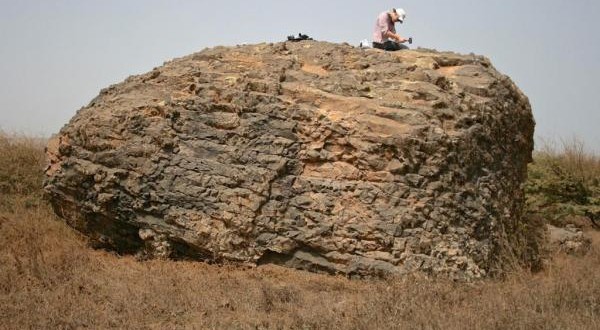Scientists may have uncovered the signs of an ancient, megatsunami that could foretell a modern hazard. Researchers have found evidence of the sudden collapse of a volcano that generated an ocean tsunami that dwarfed anything seen by humans.
The collapse of the volcano occurred about 73,000 years ago at the Fogo volcano.
The Fogo volcano at Cape Verde, which triggered the unprecedented wave, remains one of the world’s largest and most active island volcanoes.
The volcano suddenly became active late last year.
Seismologists said the eruption in November was one of the strongest ever recorded on the island.
Experts fear another powerful eruption could send a devastating mega-tsunami across the Atlantic Ocean.
Scientists have recently uncovered the terrifying details behind the ancient natural disaster.
The waves were so powerful they launched boulders the size of delivery vans into mountains more than 30 miles away.
Academics from Bristol University’s School of Earth Sciences believe the threat of an incident on a similar magnitude “still exists”.
Lead researcher Dr Ricardo Ramalho has warned such a wave, twice as high as Big Ben, would wreak untold destruction.
He said: “Our point is flank collapses can happen extremely fast and catastrophically, and therefore are capable of triggering giant tsunamis.
“We need to take this into account when we think about the hazard potential of these kinds of volcanic features.
“Fogo Island presently towers 9,281 ft (2,829m) above sea level, and erupts about every 20 years.
“We need to be vigilant.
“These findings stand as a warning that the hazard potential of volcanic island lateral collapses should not be underestimated, and consequently our society needs to do more to improve its resilience to such a threat.”
“The potential energy for a new collapse exists but what we don’t know if or when this is ever going to happen.”
The prehistoric mega-tsunami took place after a sudden eruption and landslide shook the archipelago of Cape Verde, off the coast of Western Africa.
Gigantic boulders weighing up to 770 tons fell into the ocean, releasing a 800ft (244m) high tsunami wave that engulfed the nearby island of Santiago.
In proportion, the Boxing Day tsunami of 2004, which is the largest tsunami in recent history, only reached a peak height of 100ft but still killed around 220,000 people along the coast of the Indian Ocean.
However, tsunami expert Professor Bill McGuire, from University College London, urged caution.
He claimed such mega-tsunami events occur only once every 10,000 years.
But, he added: “Nevertheless, the scale of such events, as the Fogo study testifies, and their potentially devastating impact, makes them a clear and serious hazard in ocean basins that host active volcanoes.”
Scientists have long debated whether volcanic island collapses could happen catastrophically and trigger giant tsunamis.
The latest findings discovered rocks found 650 feet above sea level on the island of Santiago matched those from Fogo, 34 miles away.
Earlier this year, U.S., physicist Michio Kaku warned a natural disaster of ‘titanic proportions’ is long overdue to strike the Earth.
Dr Kaku said: “It’s not a question of if, it’s a question of when.”
Agencies/Canadajournal
 Canada Journal – News of the World Articles and videos to bring you the biggest Canadian news stories from across the country every day
Canada Journal – News of the World Articles and videos to bring you the biggest Canadian news stories from across the country every day



